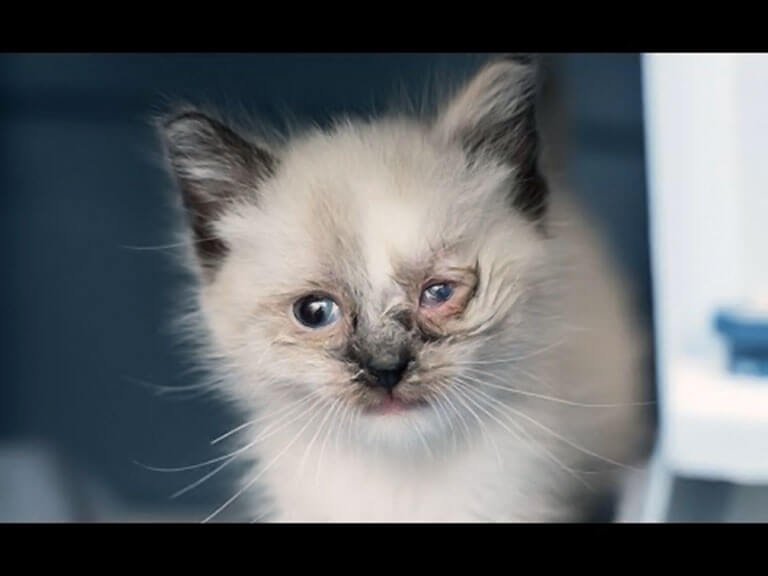Pictures of Cat Eye Problems: A Visual Guide to Warning Signs
Cat eye problems can manifest in various ways, including redness, discharge, or cloudiness. Identifying these symptoms early can prevent serious health issues.
Cats rely heavily on their eyesight for everyday activities, making eye health crucial. Common cat eye problems include conjunctivitis, cataracts, and corneal ulcers. Each condition may present different symptoms, such as watery eyes or sensitivity to light. Pet owners should monitor their cats closely for any changes in eye appearance or behavior.
Early detection and treatment are vital for maintaining your cat’s overall well-being. Regular vet check-ups can help catch potential issues before they escalate. Understanding these conditions enhances your ability to care for your feline friend effectively and ensures a happy, healthy life.
Introduction To Feline Vision Health

Feline vision health is vital for your cat’s overall well-being. Cats rely heavily on their sight to navigate their environment. Understanding common eye problems helps ensure your cat stays healthy and happy.
Importance Of Recognizing Eye Issues
Early detection of eye problems can prevent serious conditions. Regular monitoring helps maintain your cat’s quality of life. Here are key reasons to watch for eye issues:
- Prevention of more severe health issues.
- Improved quality of life for your cat.
- Cost savings on future vet visits.
- Enhanced comfort for your furry friend.
Common Signs Of Eye Problems In Cats
Recognizing signs of eye problems is essential. Here are common symptoms to look for:
- Red or swollen eyes
- Excessive tearing or discharge
- Cloudy or dull eyes
- Squinting or keeping eyes closed
- Changes in behavior (hiding, aggression)
If you notice any of these signs, consult your vet. Early intervention can make a significant difference.
Common Cat Eye Disorders
Cat eye disorders can lead to serious health issues. Understanding these conditions helps ensure your cat’s well-being. Below are two common eye disorders that pet owners should be aware of.
Conjunctivitis In Cats
Conjunctivitis is an inflammation of the eye’s outer membrane. This condition can affect one or both eyes. It often causes discomfort for your cat.
- Symptoms:
- Red or swollen eyes
- Excessive tearing
- Squinting or rubbing eyes
- Discharge from the eye
- Causes:
- Infections (bacterial or viral)
- Allergies
- Foreign objects in the eye
- Treatment:
- Veterinary examination
- Antibiotic eye drops
- Allergy medications
Cataracts And Their Impact On Vision
Cataracts are cloudy areas in the lens of the eye. They can significantly affect your cat’s vision. Cats with cataracts may have trouble seeing in bright light.
| Stage | Symptoms |
|---|---|
| Early | Minor blurriness |
| Moderate | Difficulty seeing at night |
| Advanced | Complete loss of vision |
Treatment options include:
- Regular veterinary check-ups
- Possible surgery
- Monitoring for progression
Early detection is crucial for effective treatment. Keep an eye on your cat’s behavior and report any changes to the vet.
Identifying Infections And Inflammations
Identifying eye infections and inflammations in cats is crucial. Early detection helps prevent serious issues. Common signs include redness, discharge, and swelling. Understanding these symptoms is key to effective treatment.
Symptoms Of Feline Eye Infections
Feline eye infections can show various symptoms. Pay attention to these warning signs:
- Redness: Look for redness around the eye.
- Discharge: Notice any pus or watery fluid.
- Swelling: Check for puffiness around the eye.
- Sensitivity: Observe if your cat avoids bright lights.
- Squinting: Watch for frequent squinting or closing of the eye.
These symptoms may indicate an infection. Quick action can save your cat from discomfort.
Treating Eye Inflammations In Cats
Treating eye inflammations requires careful steps. Always consult a veterinarian first. They will diagnose the issue accurately. Common treatments include:
| Treatment | Description |
|---|---|
| Antibiotic Drops | Reduces bacteria and infection in the eye. |
| Anti-inflammatory Medications | Reduces swelling and discomfort. |
| Warm Compresses | Soothes irritation and helps with drainage. |
Always follow your vet’s instructions. Monitor your cat’s progress closely. Regular check-ups ensure your cat stays healthy.
The Dangers Of Trauma And Injury
Cat eyes are delicate and vulnerable. Injuries can happen easily. Trauma can occur from fights, accidents, or falls. These injuries may lead to serious complications. Swift action can prevent long-term damage.
Common signs of trauma include:
- Swelling around the eyes
- Redness or discharge
- Excessive squinting or tearing
- Cloudiness in the eye
Recognizing these signs early is crucial. Immediate care can save your cat’s vision.
First Aid For Cat Eye Injuries
Here are steps to take in case of an eye injury:
- Stay calm. Your cat may be scared.
- Gently examine the eye. Look for visible wounds.
- Flush the eye with clean water. Use a syringe if needed.
- Apply a cold compress. This helps reduce swelling.
- Do not use any ointments or medications without a vet’s advice.
Keep your cat calm during this process. Speak softly and handle gently.
When To Seek Veterinary Care
Visit the vet immediately if you notice:
- Severe bleeding from the eye
- Cloudiness that doesn’t clear
- Signs of pain, like excessive meowing
- Inability to open the eye
Timing is critical for eye injuries. Delaying care can worsen the situation. Early intervention can save your cat’s sight.
Allergies And Their Effect On Cat Eyes
Allergies can cause serious issues for your cat’s eyes. They may lead to redness, swelling, and discharge. Knowing the triggers helps in managing these reactions effectively. Understanding how allergens affect your cat is essential for their health.
Common Allergens Affecting Cats
Many allergens can affect your cat’s eyes. Here are some common ones:
- Pollen: Seasonal allergies often come from plants.
- Dust mites: These tiny creatures are found in homes.
- Fleas: Flea saliva can cause allergic reactions.
- Mold: Spores can trigger eye irritation.
- Food: Some cats react to specific ingredients.
Managing Allergic Reactions
Managing your cat’s allergic reactions is crucial. Here are some steps you can take:
- Identify the allergen. Watch for patterns during flare-ups.
- Consult a veterinarian. They can provide tests for allergies.
- Keep your home clean. Regular vacuuming reduces dust and allergens.
- Use air purifiers. They help filter out airborne allergens.
- Consider hypoallergenic food. This can help with food allergies.
Monitor your cat’s symptoms closely. Early detection leads to better management.
| Allergen Type | Symptoms |
|---|---|
| Pollen | Red eyes, sneezing |
| Dust mites | Itchy eyes, coughing |
| Fleas | Hair loss, skin irritation |
| Mold | Watery eyes, lethargy |
| Food | Vomiting, diarrhea |
Breed-specific Eye Conditions
Different cat breeds face unique eye conditions. Understanding these issues helps in early detection and treatment. Some breeds are more prone to specific problems. This section covers conditions affecting Persian and Siamese cats.
Persian Cats And Brachycephalic Ocular Syndrome
Persian cats are beautiful but face serious eye issues. Their flat faces cause unique problems known as Brachycephalic Ocular Syndrome. This condition includes:
- Protruding eyes
- Corneal ulcers
- Dry eye syndrome
Symptoms often include:
- Excessive tearing
- Red or swollen eyes
- Frequent squinting
Regular vet check-ups are vital. Treating these symptoms early prevents further issues.
Siamese Cats And Progressive Retinal Atrophy
Siamese cats are also prone to eye problems. One major issue is Progressive Retinal Atrophy (PRA). This genetic condition leads to:
- Gradual vision loss
- Night blindness
- Possible total blindness
Signs of PRA may include:
- Bumping into objects
- Difficulty navigating in low light
- Changes in behavior
Veterinary care is crucial for managing this condition. Early detection can help maintain quality of life.
Preventive Measures For Eye Health
Maintaining your cat’s eye health is crucial. Regular care can prevent many problems. Simple steps ensure your cat’s vision remains clear and bright. Here are key preventive measures.
Regular Check-ups And Vaccinations
Regular veterinary visits are essential for your cat’s eye health. A vet can spot issues early. Vaccinations also protect against diseases that affect the eyes.
- Schedule annual check-ups.
- Discuss any vision changes with the vet.
- Keep vaccinations up to date.
Pay attention to any signs of eye problems:
- Redness or swelling.
- Discharge from the eyes.
- Squinting or excessive tearing.
Diet And Nutrition For Healthy Eyes
Nutrition plays a big role in your cat’s eye health. A balanced diet can prevent many eye issues. Certain nutrients are especially beneficial.
| Nutrient | Benefits for Eye Health |
|---|---|
| Vitamin A | Supports good vision and eye function. |
| Omega-3 Fatty Acids | Reduces inflammation and supports eye structure. |
| Zinc | Helps maintain retina health. |
Feed your cat high-quality food rich in these nutrients. Consult your vet for recommendations. Healthy eyes lead to a happy cat.
Visual Guide To Cat Eye Problems
Understanding your cat’s eye health is vital. Eyes can show signs of illness. This guide helps you recognize common eye problems in cats. Use the visual examples to identify symptoms early.
Interpreting Visual Symptoms
Look for these key symptoms in your cat’s eyes:
- Redness: Indicates irritation or infection.
- Cloudiness: May signal cataracts or other issues.
- Discharge: Yellow or green discharge shows infection.
- Swelling: Could point to allergies or injury.
- Squinting: Often a sign of pain or discomfort.
Check your cat’s eyes regularly. Early detection can prevent serious problems.
Gallery Of Cat Eye Conditions
| Condition | Description | Image |
|---|---|---|
| Cataracts | Cloudy lens affecting vision. |  |
| Conjunctivitis | Red, swollen eyes with discharge. |  |
| Corneal Ulcer | Painful sore on the eye surface. |  |
| Uveitis | Inflammation inside the eye, causing redness. |  |
Use this gallery to compare your cat’s symptoms. Consult a vet for proper diagnosis.
When To Consult A Veterinarian
Understanding your cat’s eye health is crucial. Some issues require immediate care. Others can wait for a routine check. Recognizing the signs can save your cat’s vision.
Red Flags For Immediate Attention
Pay close attention to your cat’s eyes. Look for these red flags:
- Excessive tearing or discharge
- Persistent squinting or closing of eyes
- Cloudiness or change in eye color
- Swelling around the eyes
- Visible injury or trauma
- Behavior changes, such as hiding or aggression
These symptoms may indicate serious problems. Consult a veterinarian without delay.
Routine Eye Examinations
Regular eye check-ups help maintain your cat’s health. Schedule these examinations:
- Every six months for healthy cats
- Every three months for senior cats
- After any eye injury or illness
During the exam, your vet will:
- Check for signs of infection
- Assess overall eye health
- Look for common conditions like cataracts or glaucoma
Routine checks can catch problems early. Early treatment often leads to better outcomes.
Home Care And Treatment Options
Taking care of your cat’s eye problems at home is crucial. Early intervention can prevent serious issues. Use safe remedies and medications wisely. Always consult a vet for severe conditions.
Safe Home Remedies
Home remedies can soothe minor eye issues. Here are some effective options:
- Warm Compress: Use a clean cloth soaked in warm water. Apply gently to the affected eye.
- Saline Solution: Mix 1 teaspoon of salt in 1 cup of warm water. Use a dropper to apply carefully.
- Chamomile Tea: Brew chamomile tea, cool it, and use it as an eye rinse.
- Aloe Vera: Apply a small amount of pure aloe vera gel around the eye area.
Medications And Eye Drops
Prescription medications may be necessary for serious issues. Common options include:
| Medication | Use |
|---|---|
| Antibiotic Eye Drops | Treat bacterial infections. |
| Antihistamine Drops | Alleviate allergy symptoms. |
| Anti-inflammatory Drops | Reduce swelling and redness. |
Always follow the vet’s instructions. Never use human eye drops on cats.
Technological Advances In Feline Ophthalmology
Recent years have seen remarkable progress in the field of feline ophthalmology. New technologies improve diagnosis and treatment for cat eye problems. These advances make veterinary care more effective and accessible.
Innovations In Eye Care Treatments
Veterinary medicine has embraced advanced techniques for treating cat eye issues. Here are some key innovations:
- Laser Therapy: Reduces inflammation and promotes healing.
- Topical Medications: More effective formulations for faster relief.
- Advanced Imaging: Techniques like OCT help visualize eye structures.
- Gene Therapy: Targets genetic conditions at the source.
These innovations lead to better outcomes for cats with eye problems. Early detection and treatment are crucial for preserving vision.
The Role Of Telemedicine In Eye Care
Telemedicine is changing how veterinarians provide eye care. This technology connects pet owners with specialists quickly.
Benefits of telemedicine in feline ophthalmology include:
- Convenience: Consultations from home save time.
- Accessibility: Specialists can reach remote areas.
- Cost-Effective: Reduces travel expenses for pet owners.
Telemedicine allows for prompt advice on cat eye issues. This helps in making timely decisions for treatment.
Case Studies And Success Stories
Discovering how cats overcome eye problems inspires many pet owners. These stories highlight resilience and the importance of proper care.
Recovery Tales From Eye Problems
Many cats have faced eye issues. Here are some inspiring recovery stories:
- Whiskers: Suffered from conjunctivitis. After treatment, Whiskers regained clear vision.
- Mittens: Had a severe corneal ulcer. With surgery, she now sees perfectly.
- Shadow: Diagnosed with cataracts. After a successful operation, he enjoys life again.
| Cat Name | Condition | Treatment | Outcome |
|---|---|---|---|
| Whiskers | Conjunctivitis | Medication | Full Recovery |
| Mittens | Corneal Ulcer | Surgery | Perfect Vision |
| Shadow | Cataracts | Operation | Enjoys Life |
Lessons Learned From Feline Eye Conditions
Each recovery story teaches valuable lessons. Key takeaways include:
- Early Detection: Catching issues early can save vision.
- Regular Vet Visits: Routine check-ups ensure eye health.
- Proper Medication: Following treatment plans leads to success.
- Owner Awareness: Understanding symptoms aids in quick action.
These stories show that with the right care, cats can thrive despite eye problems. Owners play a crucial role in their pets’ recovery.
Frequently Asked Questions
What Are Common Cat Eye Problems?
Common cat eye problems include conjunctivitis, cataracts, and corneal ulcers. Regular vet check-ups can help detect these issues early.
How Can I Identify Eye Issues In Cats?
Look for redness, discharge, squinting, or excessive tearing. Any unusual behavior should prompt a vet visit.
What Causes Eye Infections In Cats?
Eye infections in cats can result from allergies, foreign bodies, or bacteria. Keeping the environment clean helps prevent infections.
Can Cat Eye Problems Be Treated At Home?
Minor issues like mild irritation may improve with home care, but always consult a veterinarian for proper diagnosis and treatment.
How Often Should I Check My Cat’s Eyes?
Regularly inspect your cat’s eyes during grooming. Look for any changes and contact a vet if something seems off.
Conclusion
Understanding cat eye problems is crucial for every cat owner. Recognizing symptoms early can lead to timely treatment. Always consult a veterinarian if you notice any issues. Regular eye checks can help maintain your cat’s health. Share this information to raise awareness and keep our feline friends safe and happy.






